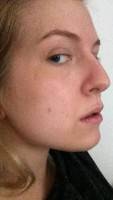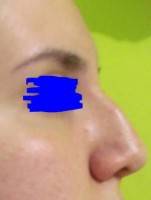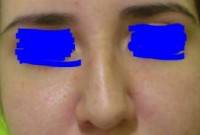Closed Rhinoplasty For Dorsal Hump
The leveling of a dorsal hump normally entails some filing of the bony portion of the hump and actual sharp excision of the cartilage portion of the hump. If that is the only problem with the nose then very likely no other procedures are required. If however, the removal of the hump leaves a flat surface of the nose which is more wide than desired, then it may be necessary to cut the nasal bones, moving them together and narrowing the dorsum of the nose. (John J. Edney, MD, Omaha Plastic Surgeon)
Dorsal Hump in Closed Rhinoplasty
As you describe it, you have a very small hump on the top of your nose and this is your only concern. If that is the case, then closed rhinoplasty with shaving down the bump would provide an excellent result.
The main thing to be aware of is that it is very dependent on how “small” the hump is. The issue would be if after filing down the hump the rest of the nose appears to be too wide or if there is separation between the bones on the top of the nose.
Usually when I offer a patient a closed rhinoplasty in this scenario I inform them of the possibility that I still may need to crack the nasal bones (osteotomy) in order to bring the bones together and prevent that gap, known as the “open roof”. (Cory Goldberg, MD, Toronto Plastic Surgeon)
Just the hump
It may be “just the hump” but the nose is a complex structure and all the parts are interrelated. Think of the nose as a tunnel not a solid structure and depending upon the thickness of the bone and cartilage a simple rasp can lead to an open area between the sidewalls.
And the thing about rhinoplasty is that deficiencies in technique often do not reveal themselves for many months or even years as swelling subsides and tissues thin with the aging process. Many plastic surgeons prefer to address the nose as a separation of its components – much like taking apart a watch–and then reassembling in painstaking fashion.
This is the advantage of open rhinoplasty. Nonetheless there are some very skilled surgeons who do closed rhinoplasty and will know if your nose could be managed that way. (R. Laurence Berkowitz, MD, San Jose Plastic Surgeon)
Filing a small hump makes a nice change…
If the hump is small it can certainly be filed down without breaking the bones through a closed approach. If the bump is larger, then the nasal bones will need to be brought in to regain the proper shape of the nose. It is most important to find an experienced surgeon who knows which way it needs to be done. (Andrew Miller, MD, Edison Facial Plastic Surgeon)
Reducing a nasal hump without rebreaking the nose.
In my experience, it is the relatively rare exception rather than the rule that a dorsal hump on the nose can be removed without the need to fracture the nose. This is because most of these bumps or humps are a combination of bone and cartilage. If you take down the bony component without fracturing the nose, the dorsum or bridge can look unnaturally squared off as the bones do not angle in on their own without fracturing. Careful inspection on the nose is paramount in making the proper treatment plan. (Arthur N. Falk, MD, Albany Facial Plastic Surgeon)
Filing the hump down only
If the hump is small, filing it down on its own is reasonable though without seeing your pictures this is difficult to tell. In general, 9 out of 10 times, osteotomies, or breaking of the nose, is required. There are occasional cases where the hump is subtle and a mild rasping of the bone is all that is needed without addressing the width of the nasal bridge or closing an ‘open roof’ created by the rasping. (Mike Majmundar, MD, Atlanta Facial Plastic Surgeon)
Filing down a dorsal hump
Filing down a small dorsal hump can be accomplished without osteotomies as long as the hump is small and an open roof deformity is not created by the filing technique. If an open roof deformity is present, then osteotomies will be required to close it. In the majority of cases osteotomies are required when performing a rhinoplasty. (William Portuese, MD, Seattle Facial Plastic Surgeon)
Small hump on the Dorsum of the nose?
In the situation where you have just a small hump, a closed rhinoplasty to shave it down is in theory perfectly reasonable. The hump reduction may necessitate adjusting the width of you bridge to fit you face. WIthout seeing pictures of your nose it is difficult to say that you won’t need any other parts of the nose adjusted to compliment the hump reduction. Generally speaking Closed Rhinoplasty should be used in patients who require less work.
The advantage is a faster surgery, and faster recovery with less swelling. The disadvantage is reduced ability of the surgeon to manoeuvre instruments, and the loss of the direct line of site you get from an Open procedure. In the case of where a patient needs lots of spreader grafts or is undergoing a revision rhinoplasty, Open Rhinoplasty is the prefered method. At the end of the day you should have your procedure done correctly, using whichever procedure your surgeon feels will comfortably get you the results you desire. Don’t compromise on your face. (Ramtin Kassir, MD, Wayne Facial Plastic Surgeon)
Filing Down the Dorsal Hump
Closed rhinoplasty or “endonasal rhinoplasty” is a great option for taking down a dorsal hump. As for osteotomies, it depends on the size and width of your hump. Many humps are large enough that their removal alone can cause a wide, flat spot. This is known as an “open roof” deformity.
The osteotomies are done to medialize the nasal bones to close the roof (the tradeoffs are stepoffs alone where the nasal bones meet the cheek). In certain cases, where the hump is small, it may not be necessary to perform osteotomies. If osteotomies are not performed, your recovery and bruising after the operating is usually not as bad. (Michael M. Kim, MD, Portland Facial Plastic Surgeon)
Depends on the extent of the dorsal hump
A dorsal hump may require as little as shaving the bony hump down to as much as performing an osteotomy (breaking the bone) and shaving the cartilage down (often the bony hump extends into the junction with the septum).
The extent of treatment requires an examination of your nose to determine the amount of bony and cartilaginous involvement. If there is indeed just a small bony hump then this can likely be fixed with rasping (filing) of the hump through a closed rhinoplasty approach and you would not need any further work on any other part of the nose.
A larger hump may require removal of bone and cartilage as well as breaking the bones to narrow the bridge so that you do not have a widened nasal bridge from taking down the hump and your nasal breathing does not get affected. (Kristina Tansavatdi, MD, Los Angeles Facial Plastic Surgeon)
Rhinoplasty Surgery & Correcting the Dorsal Hump
Closed rhinoplasty can often be utilized to correct small isolated dorsal humps. In most cases, these humps consist of both cartilage and bone. Correction involves filing the bone and shaving the cartilage.
In many cases, infracture of the nose can be avoided when nasal humps are small. When nasal humps become larger, fracture of the nose is necessary to avoid secondary aesthetic issues. It’s essential that a careful analysis of your nose be undertaken prior to surgery.
Each patient has unique anatomic findings and specific aesthetic goals and results are optimal when treatment is individualized to address these issues. This assessment should be performed by a surgeon with rhinoplasty experience. When this approach is utilized, results are usually excellent. (Richard J. Bruneteau, MD, Omaha Plastic Surgeon)
Dorsal hump rhinoplasty
It depends on the size of the hump. If it is small, then you can simply file this down without external incisions.
However, if it is larger, you may need osteotomies. That portion of the nose (dorsum) is shaped like a tent, if you take off of the top part, the sides will no longer be in contact with the top and it will look like a trapezoid, leading to a broad appearance of the dorsum and an “open roof deformity”.
The osteotomies allow the nasal bones to come in towards the middle and recreate the natural curvature of the nose.
Generally, this gives a better shape to the nose and people are happy that they had them. (Angela Sturm, MD, Houston Facial Plastic Surgeon)
Definitely yes
Small or large dorsal humps can be reduced using closed rhinoplasty techniques. However, even with many small dorsal humps, the bones may need to be narrowed because once the hump is removed, the dorsum will appear wider and you may see and feel sharp edges of the nasal bones. The surgeon should be able to tell you by looking at the size of your hump if he/she would need to break the bones to make the dorsum narrower.
Further more, even with small humps, spreader grafts (cartilage strips made of your own cartilage) may need to be used to prevent midnasal area collapse. Again, preoperatively, your surgeon should be able to assess if you need them or not. All these steps can be done through closed rhinoplasty. (Vladimir Grigoryants, MD, Los Angeles Plastic Surgeon)
Removing a Bump (Dorsal Hump) without Breaking the Nose Bones
A closed approach (sometimes called an endonasal rhinoplasty) can be used to gain access to the nose bones from inside the nose. Then, the areas of concern can be filed (using an instrument called a rasp). As long as this does not create a flat bridge or an open roof (where the two sides of the nose don’t meet in the middle), so further work on the bones is required. (Evan Ransom, MD, Bay Area Facial Plastic Surgeon)
Correction of a small hump on the nose can be as simple as just filing the area down gently with a rasp under local or IV anesthesia.
However, in some patients if it is a larger hump a flattening effect to the dorsum may result called an “open roof” and this might require breaking or infracturing the two nasal side bones to close the area that was filed down to prevent a flattened appearance.
Even if the additional surgery is required it is considered minimal and shouldn’t take the surgeon much longer to perform. (Scott Trimas, MD, Jacksonville Facial Plastic Surgeon)
Filing down small nasal hump
Filing is a perfectly good way to treat an isolated small dorsal hump. An experienced surgeon will be able to give you advice as to the need for additional modifications after he sees you.
Your desires should be kept in mind, but his experience can keep you out of trouble. (Randy J. Buckspan, MD, Austin Plastic Surgeon)
Small dorsal hump
Usually a small hump can be address with closed rhinoplasty, alone. However, this can affect other areas of your nose and I would trust your surgeon’s advice concerning these other areas. The key is to choose a board certified plastic surgeon with a passion and eye for rhinoplasty. (Dustin L. Reid, MD, Austin Plastic Surgeon)
Rhinoplasty Bumps
Most mild bumps can be addressed through a closed approach using rasps or files.
Often times, there are other features which may need to be addressed as changing one feature of the nose affects the tip position and the width of the nasal width. (James Newman, MD, Bay Area Facial Plastic Surgeon)
Dorsal Hump Reduction
Certainly you can reduce the dorsum via a closed approach. How extensive it is just depends on how much needs to be reduced.
Sometimes the bone needs to befractured, but other times simply filing the bones and cartilage will work. (Christopher V. Pelletiere, MD, Barrington Plastic Surgeon)
Filing down the dorsal hump only
It is difficult to predict for sure whether you would require other procedures or not. However, you should recogize that when you file the hump down only, it is possible your nose may appear slightly wider. Some people perceive this as a positive thing and some people perceive this as a negative thing, but that’s the reality of altering just the hump.
The nose is a 3D structure and, as such, changing one part of it can result in a change in overall appearance, to some degree. Ultimately, though, it may be quite possible to just shave the hump down. (Deason Dunagan, MD, Huntsville Plastic Surgeon)
Small hump can be fixed via closed rhinoplasty
Reducing or smoothing a small nasal hump is a simple procedure that can easily be done via a closed rhinoplasty. A very small hump will likely be taken care of with simply rasping the bone down.
Any cartilaginous contribution can also be easily removed. However, the final determination whether nasal bones need to be cut can only be made at surgery because there’s always a risk an open roof deformity results after the hump is shaved down. If this happens, the nasal bones must be cut to mobilize them and then medialize them to close the deformity. (Corey S. Maas, MD, San Francisco Facial Plastic Surgeon)
Sculpt the dorsal hump, dont break it
Yes a dorsal hump can be approached effectivly through a closed approach. If it is mild then it may not have to be “broken.” if you want just a small amount reduced it can be done with a rasp, which looks much like a file. Or what I have had great success with is using a rotating “burr.” It is an instrument that precisely shaves down and sculpts down the nasal bone to a very smooth finish.
If the hump is very large then it can be approached also through a closed apporach but may require osteotomies or “breaking of the bones.” But keep in mind this is not as bad as it sounds. When done by an expereinced physician, it is a very gentle maneuver that rarely results in bruising. (Steven H. Dayan, MD, Chicago Facial Plastic Surgeon)
That depends on what your nose looks like and the anatomy of the nose
If you have a small hump and filing the hump does not cause your nose to be too wide after the hump is taken down, then you can avoid other procedures. Most of the time, however, the hump will create an open area near the area of where the hump was located which will need to be closed. To close the open area, oftentimes you need to break the nasal bones to fit the new level of the nasal bridge you were desiring.
I would be prepared to undergo something a little more involved than you were thinking. (Philip Young, MD, Bellevue Facial Plastic Surgeon)
The nasal hump is usually made up of bone and cartilage. So what you do is rasp down the bone and trim the cartilage. If the hump is very small, nothing else needs to be done. (George J. Beraka, MD (retired), Manhattan Plastic Surgeon)
If the bump is small, as you say, the answer is yes, and you don’t have to do anything else to the nose. If that is all that bothers you, you don’t have to do the “whole nose”! (Toby Mayer, MD, Manhattan Plastic Surgeon)
Bear with me with this description: If you think of your nose as a teepee. You have nasal bones on either side leaning in as the wall of your teepee, and you have your septum as the pole in the middle of the teepee holding things up.
The peak of the teepee is the dorsum of your nose – what you see as a hump. As you remove more and more of the peak of the teepee, the remaining portion of your nose looks flatter and wider. If it is too flat and wide, you would need to “osteotomize” or break the nasal bones that make up the sidewalls in order to give your nose the appropriate narrower look.
A small hump may not need an osteotomy, a large hump likely will need an osteotomy. (Edward S. Lee, MD, Englewood Plastic Surgeon)
Nasal hump removal
If it is a very small bump on the nose, then sometimes filing it down is all thay you would need. If it is a large bump, then when it is filed, it sometimes looks a bit flat and then the bones need to be osteotomized( broken methodically) to reset the normal pyramid shape of the bones. (Steven Wallach, MD, )
Rhinoplasty and Humpectomies
The nasal hump is composed of bone and cartilage. Most small humps can be reduced with rasping and removal of cartilage using an endonasal (closed) approach. Most good rhinoplasty surgeons will assess the profile and determine if – after removing the hump – osteotomies are require to narrow any flatness on the dorsum.
It is important to remember – there is no “simple” rhinoplasty – even a simple hump reduction may require osteotomies and can develop scar tissue during the healing process. I recommend selecting a Board Certified Plastic Surgeon with extensive experience doing rhinoplasties. (Daniel Reichner, MD, Newport Beach Plastic Surgeon)
Shaving down the ‘hump’ only may create a flat appearing nose.
Shaving down the ‘hump’ only may create a flat appearing nose if you have a significant hump. This may create an ‘open roof’ deformity. Many patients benefit from ‘breaking’ of the bones following hump reduction to create improved nasal harmony. (Sanjay Grover, MD, Orange County Plastic Surgeon)
Possibly!
A nose is a three-dimensional object in the shape of a three sided pyramid. If you adjust only one aspect of the nose, you may create disharmony. In your situation, unless your bump is extremely small, shaving it down may actually cause the middle one-third of your nose to look wider.
This will give your nose a more globular, indistinct look. Your profile will be better, but people looking at you head-on will see something that just doesn’t fit. In this situation your surgeon then has to narrow the bones to restore symmetry. But, now you have a narrow body to your nose, and the tip, which was left alone, looks too wide! It can start a vicious cycle.
Give your surgeon the leeway necessary to help you make a good decision in terms of the procedure(s) that would obtain your surgical goals.
Rhinoplasty is considered the hardest cosmetic surgical procedure to perform so make sure your surgeon has a comfortable level of experience. (Manish H. Shah, MD, FACS, Denver Plastic Surgeon)
Avoid the “open roof” deformity
As one of my colleagues below touched on, the problem with “only” rasping down the nasal bones is that the nasal bones and cartilage are quite thin – a few millimeters, really – so that anything more significant than a tiny hump will require rasping right through those thin plates of bone and cartilage.
This creates what is known as an “open roof” deformity, which can become unsightly over time. To close the open roof requires cuts in the bone where the nasal bones meet the facial bones (well, the nasal processes of the maxillae). I’m often surprised, though, by the term “breaking” the bones, which implies a brutal, imprecise, and painful process. Osteotomies – literally, bone cutting – should be precise, delicate, and minimally traumatic.
Besides, even without osteotomies, the rasping of the bones and soft-tissue dissection required for even closed rhinoplasty is still a significant surgical procedure. The least of a patient’s concern should be the osteotomies, if the patient is in the hands of a competent surgeon. The focus should always be on achieving a safe, natural, unoperated result that can withstand the test of time. (David C. Pearson, MD, Jacksonville Facial Plastic Surgeon)
Probably you can have what you describe
Without photos of your nose, it is impossible for any of us to comment specifically on the question you ask. However, IF all you need and want is a conservative dorsal hump removal, that should be possible through a closed approach. (Richard P. Rand, MD, FACS, Seattle Plastic Surgeon)
The Subtle Rhinoplasty, or the “Dr. No-Name” Nose Job
Sounds like you need a subtle rhinoplasty. Name nose job because in the past, there were surgeons whose rhinoplasty patients all came out looking so alike that the “look” became the egocentric “Dr. Smith” nose job.
Today, cookie cutter noses are no longer acceptable. Each nose is different, as are the desires and goals of each patient. Therefore, sometimes all that needs to be done is “a little filing down of the hump”.
That is not to say that after filing the hump down, another subtle change may be required. Your surgeon should discuss with you and be prepared to address anything that may be required in the operating room. One of the most important aspects of successful rhinoplasty is careful and thorough examination of the nose to establish the proper diagnosis of what is causing the deformity, the best way to address it, and the effects that the intervention will have on the remainder of the nose. All of this being said, it is most difficult to answer your question precisely without seeing photographs of your nose, and/or examining it carefully. (Michael A. Persky, MD, Encino Facial Plastic Surgeon)



